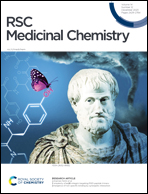Discovery of pyrazolopyrimidines that selectively inhibit CSF-1R kinase by iterative design, synthesis and screening against glioblastoma cells†
Abstract
Glioblastoma multiforme (GBM) is the most aggressive type of brain cancer in adults, with an average life expectancy under treatment of approx. 15 months. GBM is characterised by a complex set of genetic alterations that results in significant disruption of receptor tyrosine kinase (RTK) signaling. We report here an exploration of the pyrazolo[3,4-d]pyrimidine scaffold in search for antiproliferative compounds directed to GBM treatment. Small compound libraries were synthesised and screened against GBM cells to build up structure–antiproliferative activity–relationships (SAARs) and inform further rounds of design, synthesis and screening. 76 novel compounds were generated through this iterative process that found low micromolar potencies against selected GBM lines, including patient-derived stem cells. Phenomics analysis demonstrated preferential activity against glioma cells of the mesenchymal subtype, whereas kinome screening identified colony stimulating factor-1 receptor (CSF-1R) as the lead's target, a RTK implicated in the tumourigenesis and progression of different cancers and the immunoregulation of the GBM microenvironment.

- This article is part of the themed collections: Celebrating the scientific accomplishments of RSC Fellows and World Cancer Day 2024: Showcasing cancer research across the RSC


 Please wait while we load your content...
Please wait while we load your content...